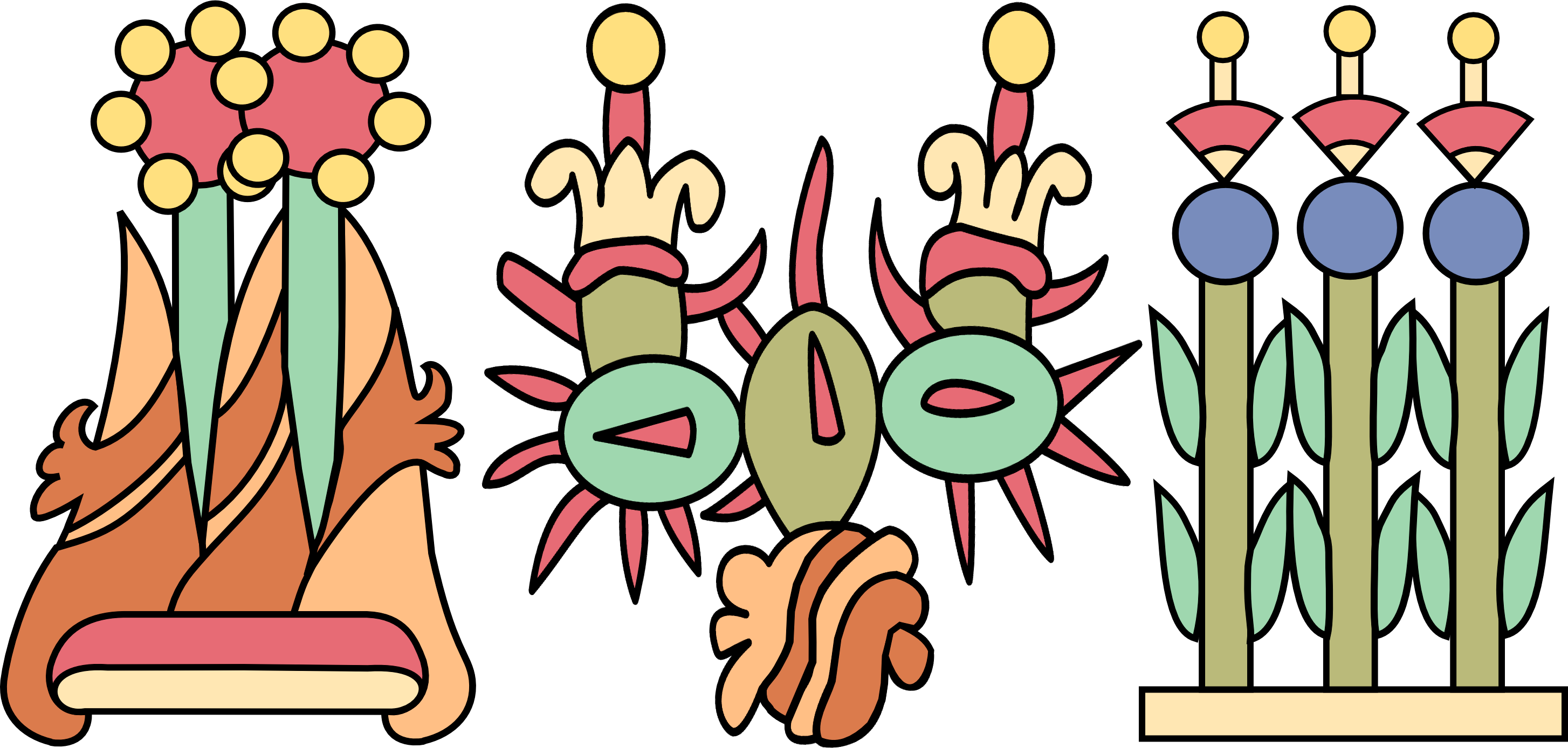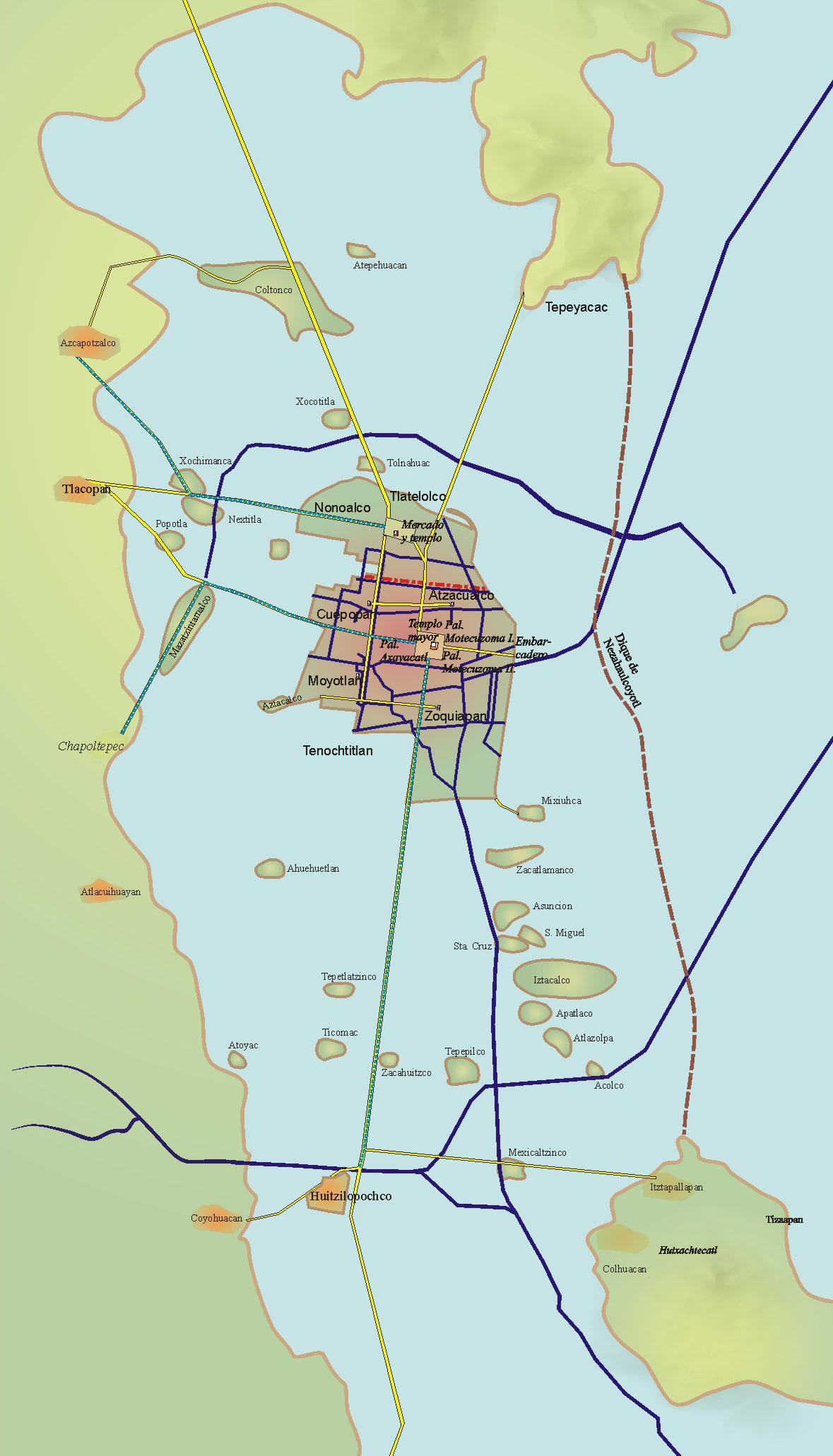|
Quauhtlatoa
Quauhtlatoa (or Cuauhtlatoa) ( 1 Flint (1428)Chimalpahin (1997): pp. 130–131. – 4 Reed (1431)Chimalpahin (1997): pp. 232–233./ 7 Flint (1460)Chimalpahin (1997): pp. 132–133./8 House (1461) Codex Telleriano-Remensis: f. 33v.) was a tlatoani (king, ruler) of the Nahua city-state Tlatelolco. Biography He was a son of Prince Acolmiztli of Tlatelolco, grandson of the King Tlacateotl and great-grandson of Quaquapitzahuac Quaquapitzahuac (died 1417) was the first ruler of the Aztec city of Tlatelolco. His name, which means "Slender Horn", was pronounced in Classical Nahuatl, and is also spelled Cuacuauhpitzahuac, Cuacuapitzahuac, and Quaquauhpitzahuac. His neph .... He was a successor of his grandfather and was killed by the Tenochca. The Annals of Cuauhtitlan (in Bierhorst 1992) give Quauhtlatoa as a father of King Tezozomoctli. Notes {{reflist Tlatoque of Tlatelolco 15th-century monarchs in North America 15th-century indigenous people of the Americas ... [...More Info...] [...Related Items...] OR: [Wikipedia] [Google] [Baidu] |
Tlacateotl
Tlacateotl (or Tlacateotzin; ? – 1426 or 1427/28) was the second Tlatoani of the Aztec city of Tlatelolco from 1417 until his death. Reign Under his rule the Tlatelolcas continued to expand their wealth and influence within the valley of Mexico. Through trade and tribute, the city's market grew to include trade in wool, jade and quetzal feathers. Tlacateotl also ordered the removal of sculptures from the ruins of Tula to decorate the growing city. His reign ended in 1426 or 1427/8 during the succession struggle in Azcapotzalco between Tayatzin and Maxtla. He is recorded as having been stoned to death while traveling by canoe. Maxtla is commonly assumed to have ordered the murder, possibly due to a suspected affair between Tlacateotl and Maxtla's wife. He was succeeded by his grandson, Quauhtlatoa. Family He succeeded his father, Quaquapitzahuac, upon his death in 1417. He was a brother of the queens Matlalatzin and Huacaltzintli and grandson of the famous king Tezozomoc ... [...More Info...] [...Related Items...] OR: [Wikipedia] [Google] [Baidu] |
Tlatoani Of Tlatelolco
This is a list of the ''tlatoque'' of the pre-Columbian era ''altepetl'' of Tlatelolco. Pre-Hispanic rulers Colonial rulers See also *List of rulers of Tenochtitlan * List of rulers of Tetzcoco * Family tree of Aztec monarchs *Aztec Empire Notes References *{{cite book , author=Chimalpahin Cuauhtlehuanitzin, Domingo Francisco de San Antón Muñón , authorlink=Chimalpahin , year=1997 , title=Codex Chimalpahin: society and politics in Mexico Tenochtitlan, Tlatelolco, Texcoco, Culhuacan, and other Nahua altepetl in central Mexico: the Nahuatl and Spanish annals and accounts collected and recorded by don Domingo de San Antón Muñón Chimalpahin Quauhtlehuanitzin , others=edited and translated by Arthur J. O. Anderson and Susan Schroeder , series=The Civilization of the American Indian Series , location=Norman , publisher=University of Oklahoma Press , isbn=0-8061-2921-2 01 Tlatelolco Tlatelolco Rulers A ruler, sometimes called a rule, line gauge, or scale, is a ... [...More Info...] [...Related Items...] OR: [Wikipedia] [Google] [Baidu] |
Moquihuix
Moquihuix (or Moquihuixtli) (died 1473) was the fourth ''tlatoani'' (ruler) of Tlatelolco. He died in 1473 in the Battle of Tlatelolco, a military conflict fought between Tlatelolco and Tenochtitlan. Moquihuix was married to Chalchiuhnenetzin, younger sister of the Tenochca ruler Axayacatl, after whom their son Axayaca was named. However, it is said that Moquihuix neglected Chalchiuhnenetzin, preferring the company of other women. A funerary urn that may belong to Moquihuix was found in 1978 at the site of the Templo Mayor of Tenochtitlan, near the Coyolxauhqui Stone The Coyolxāuhqui Stone is a carved, circular Aztec stone, depicting the mythical being Coyolxāuhqui ("Bells-Her-Cheeks"), in a state of dismemberment and decapitation by her brother, the patron deity of the Aztecs, Huitzilopochtli. It was red ....Umberger (2007). Notes References * * * {{S-end 15th-century births 1473 deaths Year of birth unknown Tlatoque of Tlatelolco ... [...More Info...] [...Related Items...] OR: [Wikipedia] [Google] [Baidu] |
Tlatelolco (altepetl)
Tlatelolco ( nci-IPA, Mēxihco-Tlatelōlco, tɬateˈloːɬko, ) (also called Mexico Tlatelolco) was a pre-Columbian altepetl, or city-state, in the Valley of Mexico. Its inhabitants, known as the ''Tlatelolca'', were part of the Mexica, a Nahuatl-speaking people who arrived in what is now central Mexico in the 13th century. The Mexica settled on an island in Lake Texcoco and founded the ''altepetl'' of Mexico-Tenochtitlan on the southern portion of the island. In 1337, a group of dissident Mexica broke away from the Tenochca leadership in Tenochtitlan and founded Mexico-Tlatelolco on the northern portion of the island. Tenochtitlan was closely tied with its sister city, which was largely dependent on the market of Tlatelolco, the most important site of commerce in the area. History In 1337, thirteen years after the foundation of Tenochtitlan, the Tlatelolca declared themselves independent from the Tenochca and inaugurated their first independent ''tlatoani'' (dynastic ruler). ... [...More Info...] [...Related Items...] OR: [Wikipedia] [Google] [Baidu] |
Tezozomoctli (Cuauhtitlan)
Tezozomoctli (originally Teçoçomoctli; ruled 1418Bierhorst (1992): pp. 80–81.–1430Bierhorst (1992): pp. 90–93.) was a ''tlatoani'' ("ruler" or "king") of the pre-Columbian Nahua ''altepetl'' (city-state) of Cuauhtitlan in central Mexico. His palace was located at Huexocalco. Tezozomoctli was born in the Mexica city of Tlatelolco. His father was Tlacateotl, who was the second tlatoani of Tlatelolco. His mother was Xiuhtomiyauhtzin, the daughter of the tlatoani of Coatl Ichan, Acolmiztli.Chimalpahin (1997): vol. 2, p. 113. Tezozomoctli was probably named after his great-grandfather, the powerful ruler of Azcapotzalco. In the Tepanec War in the year 3 Rabbit (1430), Cuauhtitlan was attacked and defeated by the combined forces of the surrounding peoples. After being informed at his refuge at Cincoc Huehuetocan that Cuauhtitlan had been captured, Tezozomoctli travelled to Atzompan where he allegedly committed suicide by poison Poison is a chemical substance that ... [...More Info...] [...Related Items...] OR: [Wikipedia] [Google] [Baidu] |
Codex Telleriano-Remensis
The Codex Telleriano-Remensis, produced in sixteenth century Mexico on European paper, is one of the finest surviving examples of Aztec manuscript painting. Its Latinized name comes from Charles-Maurice Le ''Tellier'', archbishop of ''Reims'', who had possession of the manuscript in the late 17th century. The Codex is held at the Bibliothèque nationale de France in Paris. Contents The Codex Telleriano-Remensis is divided into three sections. The first section, spanning the first seven pages, describes the 365-day solar calendar, called the '' xiuhpohualli''. The second section, spanning pages 8 to 24, is a '' tonalamatl'', describing the 260-day '' tonalpohualli'' calendar. The third section is a history, itself divided into two sections which differ stylistically. Pages 25 to 28 are an account of migrations during the 12th and 13th centuries, while the remaining pages of the codex record historical events, such as the ascensions and deaths of rulers, battles, earthquakes, an ... [...More Info...] [...Related Items...] OR: [Wikipedia] [Google] [Baidu] |
Tlatoani
''Tlatoani'' ( , "one who speaks, ruler"; plural ' or tlatoque) is the Classical Nahuatl term for the ruler of an , a pre-Hispanic state. It is the noun form of the verb "tlahtoa" meaning "speak, command, rule". As a result, it has been variously translated in English as "king", "ruler", or "speaker" in the political sense. Above a tlahtoani is the ''Weyi Tlahtoani,'' sometimes translated as "Great Speaker", though more usually as "Emperor" (the term is often seen as the equivalent to the European " great king"). A ' () is a female ruler, or queen regnant. The term refers to "vice-leader". The leaders of the Mexica prior to their settlement are sometimes referred to as , as well as colonial rulers who were not descended from the ruling dynasty. The ruler's lands were called , and the ruler's house was called ''Nahuatl dictionary'' (1997). Wired humanities project. Retrieved January 1, 2012, frolink/ref> The city-states of the Aztec Empire each had their own tlatoani, or ... [...More Info...] [...Related Items...] OR: [Wikipedia] [Google] [Baidu] |
Nahua Peoples
The Nahuas () are a group of the indigenous people of Mexico, El Salvador, Guatemala, Honduras, and Nicaragua. They comprise the largest indigenous group in Mexico and second largest in El Salvador. The Mexica (Aztecs) were of Nahua ethnicity, and the Toltecs are often thought to have been as well, though in the pre-Columbian period Nahuas were subdivided into many groups that did not necessarily share a common identity. Their Nahuan languages, or Nahuatl, consist of many variants, several of which are mutually unintelligible. About 1.5 million Nahuas speak Nahuatl and another million speak only Spanish. Fewer than 1,000 native speakers of Nahuatl remain in El Salvador. It is suggested that the Nahua peoples originated near Aridoamerica, in regions of the present day Mexican states of Durango and Nayarit or the Bajío region. They split off from the other Uto-Aztecan speaking peoples and migrated into central Mexico around 500 CE. The Nahua then settled in and around the ... [...More Info...] [...Related Items...] OR: [Wikipedia] [Google] [Baidu] |
Quaquapitzahuac
Quaquapitzahuac (died 1417) was the first ruler of the Aztec city of Tlatelolco. His name, which means "Slender Horn", was pronounced in Classical Nahuatl, and is also spelled Cuacuauhpitzahuac, Cuacuapitzahuac, and Quaquauhpitzahuac. His nephew was Tecollotzin. Reign Quaquapitzahuac was appointed by his father, Tezozomoc, in 1376 to serve as the first tlatoani of Tlatelolco, thus beginning that city's royal house. Under his rule, Tlatelolcan armies participated in various conquests on behalf of the city of Azcapotzalco, winning the right to receive tribute from the conquered towns in the east of the valley of Mexico. Family He was a son of famous Tezozomoc, the Tepanec ruler of Azcapotzalco. He was a brother of the kings Aculnahuacatl Tzaqualcatl, Tzihuactlayahuallohuatzin, Maxtla, Epcoatl and the queen Ayauhcihuatl. His wife was called Acxocueitl. Upon his death in 1417, he was succeeded by his son Tlacateotl. He was also a father of the queens Matlalatzin (wife o ... [...More Info...] [...Related Items...] OR: [Wikipedia] [Google] [Baidu] |
Tenochtitlan
, ; es, Tenochtitlan also known as Mexico-Tenochtitlan, ; es, México-Tenochtitlan was a large Mexican in what is now the historic center of Mexico City. The exact date of the founding of the city is unclear. The date 13 March 1325 was chosen in 1925 to celebrate the 600th anniversary of the city. The city was built on an island in what was then Lake Texcoco in the Valley of Mexico. The city was the capital of the expanding Aztec Empire in the 15th century until it was captured by the Spanish in 1521. At its peak, it was the largest city in the pre-Columbian Americas. It subsequently became a '' cabecera'' of the Viceroyalty of New Spain. Today, the ruins of are in the historic center of the Mexican capital. The World Heritage Site of contains what remains of the geography (water, boats, floating gardens) of the Mexica capital. was one of two Mexica (city-states or polities) on the island, the other being . The city is located in modern-day Mexico City. E ... [...More Info...] [...Related Items...] OR: [Wikipedia] [Google] [Baidu] |
Tlatoque Of Tlatelolco
''Tlatoani'' ( , "one who speaks, ruler"; plural ' or tlatoque) is the Classical Nahuatl term for the ruler of an , a pre-Hispanic state. It is the noun form of the verb "tlahtoa" meaning "speak, command, rule". As a result, it has been variously translated in English as "king", "ruler", or "speaker" in the political sense. Above a tlahtoani is the ''Weyi Tlahtoani,'' sometimes translated as "Great Speaker", though more usually as "Emperor" (the term is often seen as the equivalent to the European "great king"). A ' () is a female ruler, or queen regnant. The term refers to "vice-leader". The leaders of the Mexica prior to their settlement are sometimes referred to as , as well as colonial rulers who were not descended from the ruling dynasty. The ruler's lands were called , and the ruler's house was called ''Nahuatl dictionary'' (1997). Wired humanities project. Retrieved January 1, 2012, frolink/ref> The city-states of the Aztec Empire each had their own tlatoani, or l ... [...More Info...] [...Related Items...] OR: [Wikipedia] [Google] [Baidu] |




